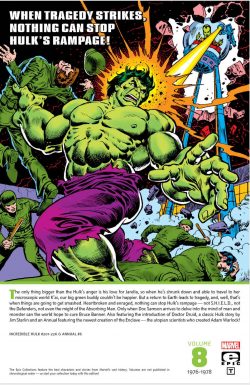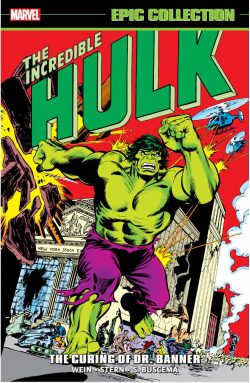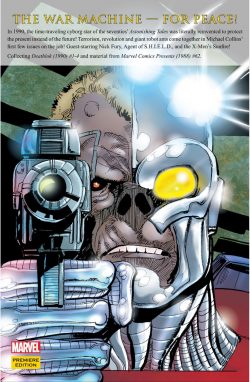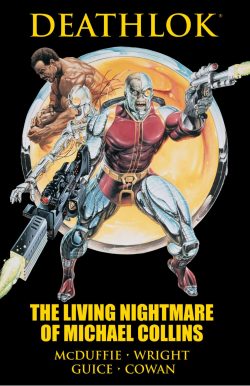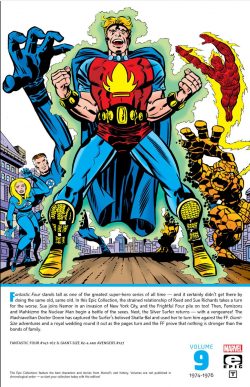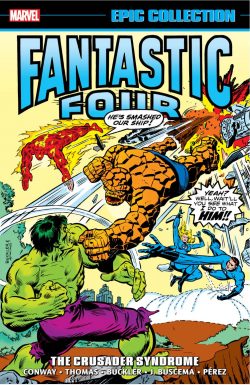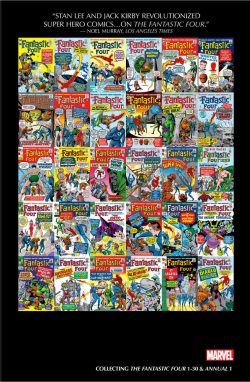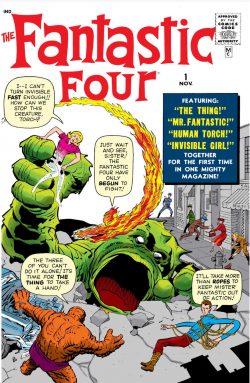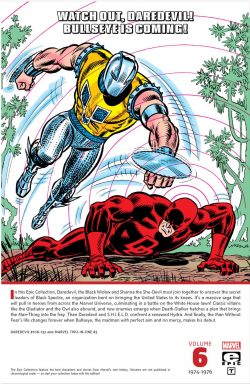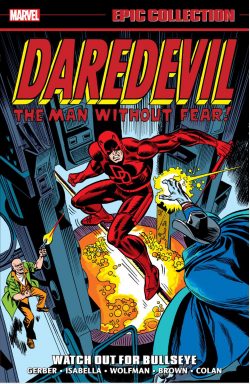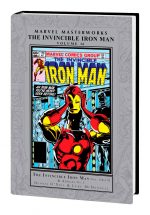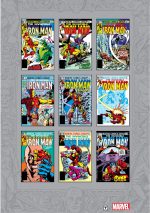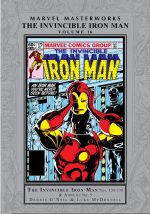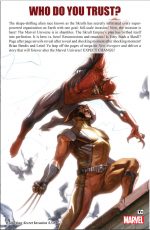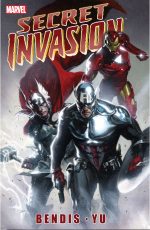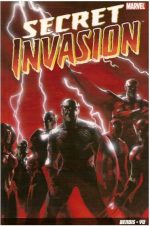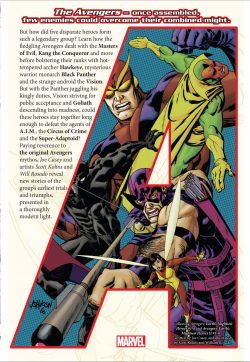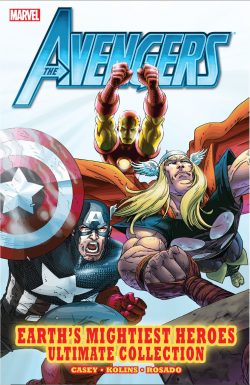

By Steve Englehart, Mike Friedrich, Roy Thomas, Tony Isabella, Sal Buscema, Alan Weiss, John Byrne, Vince Colletta, Frank McLaughlin, John Verpoorten, Frank Giacoia, John Tartaglione, George Roussos & various (MARVEL)
ISBN: 978-1-3029-4873-3 (TPB/Digital edition)
Please be aware this review concerns material with Discriminatory Content.
Created by Joe Simon & Jack Kirby in an era of ferocious patriotic fervour and carefully-manipulated idealism, Captain America was a dynamic and exceedingly bombastic response to the horrors of Nazism and the threat of Liberty’s loss.
He quickly lost focus and popularity once hostilities ceased: fading away as post-war reconstruction began. He briefly reappeared after the Korean War: a harder, darker sentinel ferreting out monsters, subversives and the “commies” who lurked under every American bed. Then he vanished once more until the burgeoning Marvel Age resurrected him just in time to experience the Land of the Free’s most turbulent and culturally divisive era: one where the Star-Spangled Avenger was in danger of becoming an uncomfortable symbol of a troubled, divided society, split along age lines and with many of the hero’s fans apparently rooting for the wrong side. Now into that turbulent mix crept issues of racial and gender inequality…
This resoundingly resolute full-colour Epic Collection re-presents Captain America and the Falcon #160-179 (spanning cover-dates April 1973 to December 1974) with the former patriotic symbol and full-time crimefighting partner The Falcon (Harlem-based social worker and combat acrobat Sam Wilson) confronting truly troubled times head on. The once convinced and confirmed Sentinel of Liberty was becoming a lost symbol of a divided nation, uncomfortable in his red, white & blue skin and looking to carve himself a new place in the Land of the Free. Sadly, calamitous events were about to put paid to that particular American dream…
Into an already turbulent mix of racial and gender inequality played out against standard Fights ‘n’ Tights villainy came creeping overtones of corruption and betrayal of ideals that were fuelled by shocking real-world events.
Following an informative behind-the-scenes reminiscence the drama begins courtesy of scripter Steve and artists Sal Buscema & Frank McLaughlin as ‘Enter: Solarr!’ offers an old-fashioned clash with a super-powered maniac as the main attraction. However, the real meat is the start of twin sub-plots that would shape the next half-dozen adventures, as the Star-Spangled Avenger’s newfound super-strength increasingly makes his proud partner-in-crimefighting feel like a junior and inferior hindrance, even as Steve Rogers’ long-time romantic interest Sharon Carter leaves him without a word of explanation…
Inked by John Verpoorten, CA&F #161 ramps up the tension between Steve and Sam as they search for Sharon in ‘…If he Loseth His Soul!’, and finds a connection to the girl Cap loved and lost in WWII as part of a deadly psycho-drama overseen by criminal shrink Dr. Faustus. It culminates one month later in a singular lesson in extreme therapy proving ‘This Way Lies Madness!’
CA&F #162’s ‘Beware of Serpents!’ heralded the return of super snakes Viper and Eel, who combine with The Cobra to form a vicious but ultimately unsuccessful Serpent Squad to attack the heroes. Humiliatingly defeated, former ad-exec Jordan Dixon/Viper vengefully begins a media manipulation campaign to destroy the Sentinel of Liberty with the “Big Lie”, weaponised fake news and the worst tactics of Madison Avenue. Although the instigator quickly falls, his scheme rumbles on with slow, inexorable and dire consequences…
Issue #164 offers a stunningly scary episode illustrated by Alan Lee Weiss, introducing faux-coquette mad scientist Deadly Nightshade: a ‘Queen of the Werewolves!’ who infects Sam with her chemical lycanthropy as an audition to enlist in the fearsome forces of one of the planet’s greatest menaces…
The full horror of the situation is only revealed when ‘The Yellow Claw Strikes’ (Englehart, Buscema & McLaughlin); renewing a campaign of terror begun in the 1950s, but this time attacking his former Chinese Communist sponsors and the USA indiscriminately. Giant bugs, deadly slave assassins and reanimated mummies are bad enough, but when the Arcane Immortal’s formidable mind-control dupes Cap into almost beating S.H.I.E.L.D. supremo Nick Fury to death on the ‘Night of the Lurking Dead!’, the blistering final battle results in further tragedy when an old ally perishes in the Frank Giacoia inked ‘Ashes to Ashes’…
A pause for thought: these days we comics apologists keep saying “it was a different era”, but to ignore history is to inevitably repeat it. Even before Arthur Henry Sarsfield Ward/Sax Rohmer’s ultimate embodiment of mistrust and suspicion was created, fiction has used racism as a tool for sales. However, it really took off with 1913’s The Mystery of Dr. Fu-Manchu delivering a prime archetype for mad scientists and the remorseless “Yellow Peril” which threatened (white colonial) civilization.
The character spread to stage, screen, airwaves and comics (even appropriating the cover of Detective Comics #1, heralding an interior series that ran until #28), but most importantly, the concept became a visual affirmation and conceptual basis for countless evil “Asiatics”, “Orientals” and “Celestials” who dominated popular fiction for most of the 20th century.
Like most mass entertainment forms comics companies like Marvel employed many “Yellow Peril” knock-offs and personifications (especially after China became communist after WWII) including Wong Chu; Plan Tzu AKA the Yellow – latterly Golden – Claw; Huang Zhu; Silver Samurai; Doctor Sun, the second Viper, ad infinitum: all birds of another colour that are nastily pejorative shades of saffron. These stories, crafted by Marvel’s employees were – and remain – some of the best action comics you’ll ever encounter, but never forget what they’re actually about: distrust of the obviously other; and that needs to be foremost in young minds when reading these old stories.
Comics – Marvel foremost – has sought to sensitively address issues of race and honestly attempt to share non-Christian philosophies and thought in later years. Moreover and most importantly, they were among the first to offer potently powerful role models to kids of Asian origins, and acknowledged these past iniquities.
One of the Star-Spangled Avenger’s most durable foes sort-of resurfaces in tense, action-heavy romp ‘…And a Phoenix Shall Arise!’. Scripted by Roy Thomas & Tony Isabella with inks by John Tartaglione & George Roussos, the simple throwaway yarn has taken on major significance as the soft return of one of Marvel’s most significant villains.
With additional scripting from Mike Friedrich, Englehart’s major storyline resumes as the Viper’s long-laid plans start finally bearing bitter fruit in #169’s ‘When a Legend Dies!’. With anti-Captain America TV spots making people doubt the honesty and sanity of the nation’s greatest hero, Sam and his “Black Power” activist girlfriend Leila Taylor depart for African nation Wakanda to technologically boost The Falcon’s abilities, leaving Cap to battle third-rate villain The Tumbler. In the heat of combat the Avenger seemingly goes too far and the thug dies…
‘J’Accuse!’ (Englehart, Friedrich, Buscema & Vince Colletta) reveals Cap beaten and arrested by too-good-to-be-true neophyte crusader Moonstone, whilst in Africa Leila is kidnapped by exiled Harlem hood Stone-Face, far from home and hungry for some familiar foxy ghetto-style “companionship”…
CA&F #171’s ‘Bust-Out!’ finds Cap forcibly sprung from jail by a mysterious pack of “supporters” as The Black Panther and the newly high-flying Falcon crush Stone-Face prior to a quick dash back to the USA and a reunion with its beleaguered and tarnished American icon. ‘Believe it or Not: The Banshee!’ opens with Captain America and the Falcon beaten by – but narrowly escaping – Moonstone and his obscurely occluded masters, after which the hard-luck heroes trace a lead to Nashville, only to encounter the fugitive mutant Master of Sound and stumble into a clandestine pogrom on American soil.
For many months mutants have been disappearing unnoticed, but now the last remaining X-Men – (Cyclops, Marvel Girl and Charles Xavier – have tracked them down, only to discover Captain America’s problems also stem from ‘The Sins of the Secret Empire!’ whose ultimate goal is the conquest of the nation. Eluding capture by S.H.I.E.L.D., Steve and Sam infiltrate the evil Empire, only to be exposed and confined in ‘It’s Always Darkest!’ before abruptly turning the tables and saving the day in #175’s ‘…Before the Dawn!’, wherein a vile grand plan is revealed, the mutants liberated and the culprits captured.
In a (still) shocking final scene, the ultimate instigator is unmasked and horrifically dispatched within the White House itself…
At this time America was a nation reeling from loss of unity, solidarity and perspective as a result of a torrent of shattering blows such as losing the Vietnam war, political scandals like Watergate and the (partial) exposure of President Nixon’s lies and crimes.
The general decline of idealism and painful public revelations that politicians are generally unpleasant – even possibly ruthless, wicked exploiters – kicked the props out of most citizens who had an incomprehensibly rosy view of their leaders. Thus, a conspiracy that reached into the halls and backrooms of government was extremely controversial yet oddly attractive in those distant, simpler days…
Unable to process the betrayal of all he has held dear, the Star-Spangled Avenger cannot accept this battle has any winner: a feeling that will change his life forever.
Following an attempt by sections of the elected government to undemocratically seize control by deceit and criminal conspiracy (sounds like sheer fantasy these days, doesn’t it?) Captain America can no longer be associated with a tarnished ideal and #176 sees shocked, stunned Steve Rogers search his soul and realise he also cannot be the symbol of such a country. Despite anxious arguments and advice of his Avenging allies Steve decides ‘Captain America Must Die!’ (Englehart, Buscema & Colletta).
Unable to convince him otherwise, staunch ally Sam carries on alone, tackling in the following issue a body-snatching old X-Men foe in ‘Lucifer Be Thy Name’ before wrapping up the threat in ‘If the Falcon Should Fall…!’
Steve meanwhile settles into uncomfortable retirement, as a number of painfully unqualified amateurs try to fill the crimson boots of Captain America – with dire results. Captain America and the Falcon #179 sees unsettled civilian Rogers hunted by a mysterious Golden Archer whose ‘Slings and Arrows!’ convince the ex-hero that even if he can’t be a Star-spangled sentinel of liberty, neither can he abandon the role of do-gooder: leading to a life-changing decision… as you will see in the next volume…
Bonus material in this tome includes John Romita’s cover art for F.O.O.M. #8 (December 1974 and an all Cap special). It precedes the finished 2-tone piece and articles by Roger Stern – ‘Well Come On, All You Big Strong Men…’, ‘Manchild in a Troubled Land’, ‘He Was Only Waiting For This Moment to Rise…’, photo feature ‘Star of the Silver Screen’ and tribute ‘Joe Simon and Jack Kirby – By Their Works Shall Ye Know Them’. The package ends with a back cover from young John Byrne, who also provided the majority of illustrations accompanying the features. One last treat is a preliminary page of pencils by Weiss from CA&F #164.
Any retrospective or historical re-reading is going to turn up some cringe-worthy moments, but these tales of matchless courage and indomitable heroism are fast-paced, action-packed and still carry a knockout conceptual punch. Here Captain America was finally discovering his proper place in a new era and would once more become unmissable, controversial comicbook reading, as we shall see when I get around to reviewing the next volume…
© 2023 MARVEL.




